2011/12/19, @品集生活
燈光偏昏暗,外觀顏色部分或許不準確 / Light is not so good for a tasting event, so the appearance might be incorrect.
未成年請勿飲酒,飲酒過量有礙身體健康
The name, Chardonnay, probably comes from "Chardonnay" village in Maconnais region of Bourgogne. Actually, this variety is a crossing of Gouais Blanc and Pinot (the parent of Pinot Noir and Pinot Blanc). The viticulture record of Chardonnay can be tracked back to the 1st or 2nd century. Chardonnay is the 2nd widest planted variety all over the world. The 1st variety, Airen, mostly planted in Spain, is usually used for making spirits and low quality wines.
The origination of Chardonnay variety does not comes from "Chardonnay" village, and the very beginning planting area of this variety may not be in this village. Though, the viticulture of Chardonnay became common after the 6th or 7th century, and the name "Chardonnay" was not common until 19th century. The "burst" of planting Chardonnay is from 1980-1990, and this "burst" is majorly in USA and Australia. This burst also makes USA is the #1 largest planting area of Chardonnay, and Australia takes the 2nd place (France is #3). The planting area of Chardonnay in USA comes from 7200 ha in 1980 to 40000 ha in 2005 (overpass France in 1988).
Chardonnay is an early bud and quick maturing variety, so the great regions of this variety are usually in colder areas. Skin is thin, so mold can more easily affect it. Besides, Chardonnay also has more Millerandage (berry size differs a lot, due to the blooming time difference) problems than other variety. However, Millerandage sometimes provides wine makers small berry full of flavors to making great wine.
Chardonnay also contains more diacetyl (丁二酮,屬二酮類), so it is also a good candidate variety for making noble wines. Diacetyl can contributes smooth/chewy mouthfeel and flavors into the wines. The best soils for Chardonnay is chalk soil, clay, and limestone. Chalk soil contains more carbonic acid, which is good for producing the acidity of grapes. Clay is usually not a good soil for vines, due to its high density. However, the roots of Chardonnay is more "powerful/mighty" than other varieties, so clay can help Chardonnay to construct the flavors and improve the density of flavors. Limestone soil has the advantages of clay and chalk soil.

Chardonnay is a high yield variety. 8000 L/ha can still provide normal quality, although great Chardonnay wines are usually from vineyards of about 5000 L/ha. (For other varieties, 5000 L/ha is high yield). When the weather gets warmer and berries get into the maturing period, the acidity decreasing speed and the sugar increasing speed of Chardonnay are faster than other varieties. Thus, many wine makers do not use "full mature" berries. In colder regions, the Chardonnay usually contributes green fruits, such as green apple and green lemon. In warmer region, pineapple, peach, banana, and other tropical fruit flavors are more common.
In Chile, Sauvignon Blanc is probably a more famous variety, but Chardonnay is actually the #1 planted variety, which occupies more than 7500 ha vineyards. Chile Chardonnay was similar to USA style before, but turns into less oak barrel style in these years. High acidity and green citrus flavors are the major style of Chile Chardonnay.
Chassagne-Montrachet and Puligny-Montrachet are two major communes in Cote de Beaune. Chassagne-Montrachet borders on the south of Puligny-Montrachet. Chassagne-Montrachet Chardonnay usually gives higher-tone and more oak barrel effects than Puligny-Montrachet. Puligny-Montrachet usually gives undertone image and green citrus.
Aloxe commune is the renowned commune producing Chardonnay in Cote de Nuits, and Corton-Chalemagne is the Grand cru in this commune. More smoky, acidity, strong and firm.
Shaw+Smith M3 Chardonnay 2009
[wpcol_1third id="" class="" style=""]
[/wpcol_1third] [wpcol_2third_end id="" class="" style=""] Light straw.
Light oak nose, cedar, light cream, lemon, green apple, mineral and dry grass nose.
Medium- body. Grass, green lemon, grapefruit skin, light cedar, and mineral palate. High acidity and lingering.
[/wpcol_2third_end]
Chateau Montelena Chardonnay 2009
[wpcol_1third id="" class="" style=""]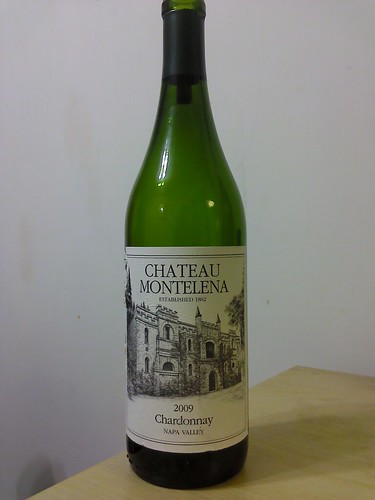
[/wpcol_1third] [wpcol_2third_end id="" class="" style=""] Light straw with blonde hue.
More wood nose than Shaw+Smith. Orange, light hazelnut, wood,mineral, butter, apple, light bouquet and honey, vanilla hint, light eucalyptus, pickled peach, and light flint.
Medium body. Grapefruit skin, orange, pineapple, and clove hint. More barrel. Citrus skin bitterness at the end. Medium-high acidity.
[/wpcol_2third_end]
Concha y Toro Amelia Chardonnay 2008
[wpcol_1third id="" class="" style=""]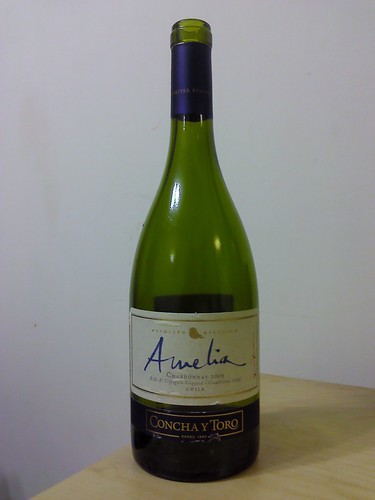
[/wpcol_1third] [wpcol_2third_end id="" class="" style=""] Medium- blond.
Medium nose. Wet grass, light black currant leaves, light smoky, wet wood, light nuts, almond, light pineapple, bouquet perfume, butter and vanilla (increasing).
Medium body. Green lemon, butter. Medium-high acidity. The palate is not as interesting as the nose.
[/wpcol_2third_end]
B. Defaix Chablis 1er Vaillon 2008
[wpcol_1third id="" class="" style=""]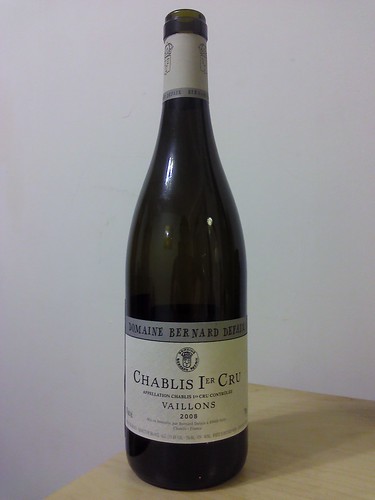
[/wpcol_1third] [wpcol_2third_end id="" class="" style=""] Medium blond.
Medium nose. Light toast, light honey, green lemon, sidewalk, and caramel red bean sauce.
Medium- body. Green lemon, yogurt, grass, mineral, citrus skin, unripe orange juice. High acidity, firm and sharp mouth feel.
[/wpcol_2third_end]
Louis Jadot Puligny-Montrachet 1er Les Perrieres 2000
[wpcol_1third id="" class="" style=""]
[/wpcol_1third] [wpcol_2third_end id="" class="" style=""] Medium- gold-blond.
Pickled prune, light oxidized nose (decreasing), light savory (decreasing), coconut cheese bread, baked chestnut, light caramel, and vanilla (increasing). Old wine nose at the beginning, but shows some young energy after breathing.
Medium body. Over ripe pineapple, mineral, walnut, and cream.
[/wpcol_2third_end]
Vincent Girardin Corton-Chalemagne 2009
[wpcol_1third id="" class="" style=""]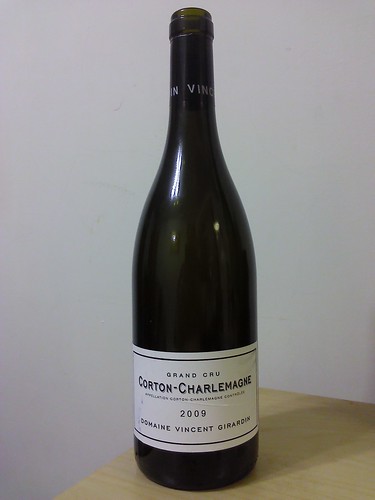
[/wpcol_1third] [wpcol_2third_end id="" class="" style=""] Medium- blond.
Mineral, mint, peach, flower, dry grass, cedar, green apple, light orange, vanilla, and charming bouquet (like rose!) in nose.
Medium body. Dry grass, mineral, citrus. High acidity.
[/wpcol_2third_end]
F. Gagnard Criot-Batard-Montrachet 2006
[wpcol_1third id="" class="" style=""]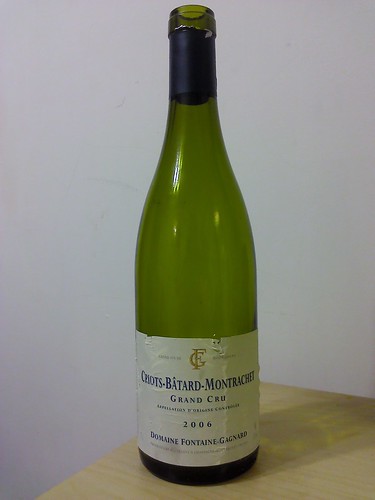
[/wpcol_1third] [wpcol_2third_end id="" class="" style=""] Medium blond with gold hue.
Bouquet, light walnut,butter, baked sliced meat, mineral, light banana, peanuts, light animal fur, and burned rosemary.
High acidity and medium+ body. Orange, citrus, wood. The palate is not as complex as the nose, but still good and very concentrated.
[/wpcol_2third_end]
Vincent Girardin Chevalier-Montrachet 2003
[wpcol_1third id="" class="" style=""]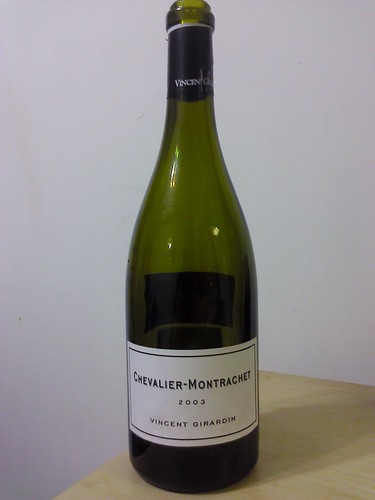
[/wpcol_1third] [wpcol_2third_end id="" class="" style=""] Medium blond with gold hue.
BUTTER!!!!, buttery toast, peach, hazelnut.
Very lingering palate. Grass, butter, oak barrel, flower.
[/wpcol_2third_end]